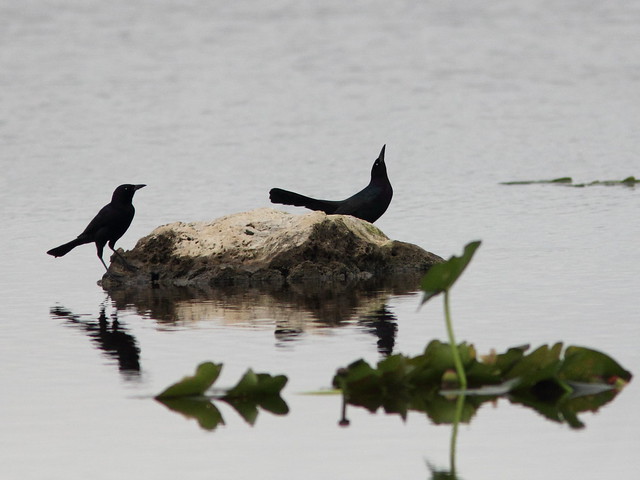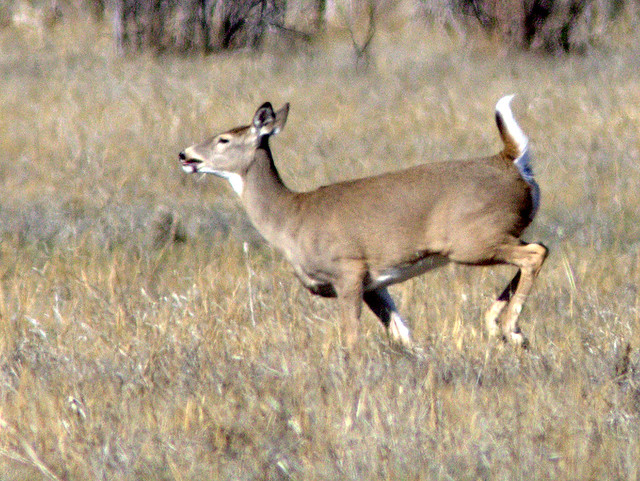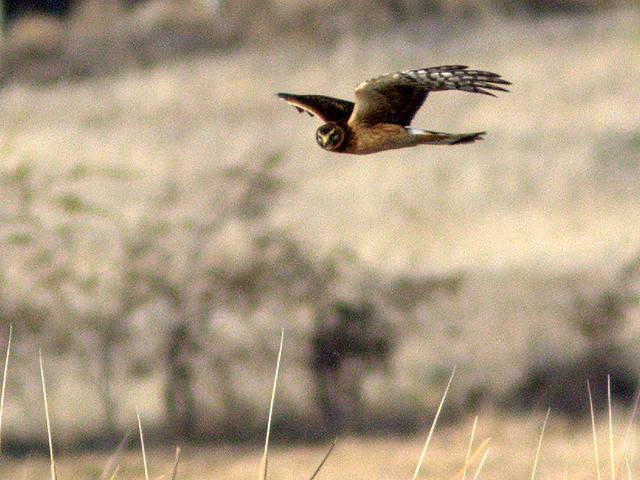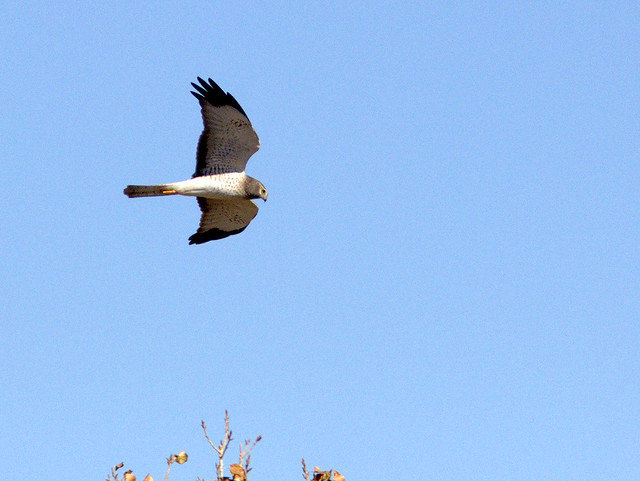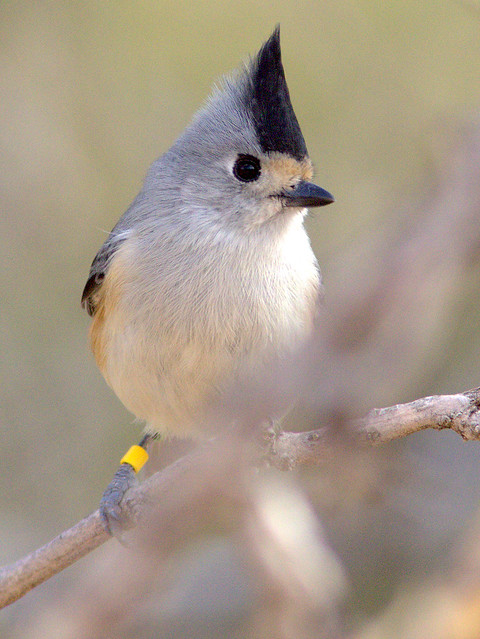During our recent visit with our son and his wife and five children in Canyon, Texas, we got in some very good birding. Our three older grandchildren guided us on local walks in their neighborhood, and we visited a local park as well as Buffalo Lake National Wildlife Refuge in nearby Umbarger.
Canyon’s Southeast Park had a pond that contained lots of waterfowl, among them two species that are quite similar, the Canada and Cackling Geese. The latter are smaller than Canada Geese, and have disproportionately shorter necks and bills. The Cackling Geese tended to stay together in a single flock and I had a difficult time trying to get the two species to pose together to allow a comparison of their identifying features. Formerly considered as a single species (along with other variations among Canada Goose populations), these two species were officially split when the American Ornithologists Union published the 45th AOU Checklist in 2004. Of the eleven subspecies that made up the Canada Goose complex, seven were allocated to the “large-bodied” Canada Goose (Branta canadensis) species and the other four to the Cackling Goose (Branta hutchinsii) species. Read more in David Sibley’s analysis at this link
In this photo, three of the larger Canada Geese are in the foreground, and those behind them are mostly Cackling Geese.
In flight, these Canada Geese (or, as their shorter bills and necks may suggest, the nearer two are Cackling Geese) lined up precisely.
Knowing that the following photo was taken in northern Texas makes it easy for me to point out that the big blackbird is not a Boat-tailed Grackle, so common around my Florida home, but rather a Great-tailed Grackle. The former is found along the Atlantic and Gulf coasts, and is strongly associated with water, while the Great-tailed Grackle ranges in the interior southwestern US. Their voices are distinctively different– the Great-tail makes very weird noises– grating, rattling and even some calls that sound exactly as if the bird is rubbing its wing feathers together.
For comparison, here is a recent photo of Boat-tailed Grackles in their typical habitat, near our Florida home.
The Texas Panhandle is experiencing its worst drought in over 50 years. Lakes are drying up and the water table has fallen severely. Buffalo Lake was quite large, and attracted huge flocks of ducks and wading birds when I first visited there in the early 1990s. Now it is almost completely dry. Even without the water, the Refuge has extensive grasslands and wooded areas.
White-tailed Deer abounded. This doe bounded across a field in front of us.
Although the grandchildren each tried to be the first to spot a deer or Wild Turkey, they were quite good at pointing out the raptors. We saw a Peregrine Falcon, American Kestrels and several Red-tailed hawks. Northern Harriers were abundant, but all were either brown females or immature cinnamon-colored birds. A with owls, their facial disks help them locate prey by amplifying sound. Hearing the faintest of squeaks, harriers have been know to plunge blindly into dense grass and come up with an entire nest of baby mice.
In this species, the smaller gray-colored adult males are less commonly seen, and are said to make up only about one in seven to twenty individuals sighted in the field. They occasionally mate with multiple females, but most are monogamous. Because of the relatively large number of immature birds, in which the sexes are quite similar, adult males are greatly outnumbered. Indeed, mis-identification of immature Northern Harriers as females probably accounts for the widespread belief that their sex ratio is heavily skewed toward females. Between 1971 and 1980, at four hawk watch banding stations in north-central and northeastern states, 90% of 1256 harriers captured during migration were juveniles, but among adults the sex ratio of males to females was close to 1:1 (Reference). A large California study found that, over a 24 year period (1960 - 1983) , the female to male ratio averaged 1.1 : 1 (with an annual variation of 0.8 to 1.6 : 1) (Reference). This is so interesting, as I used to think that there had to be a lot of unattached non-breeding females left over, which would confer no evolutionary advantage for the species.
Our eldest grandson sighted this beautiful male Northern Harrier when it was some distance away, giving me plenty of time to get my camera into action.
Both Eastern and Western Meadowlarks are present at Buffalo Lake, but this one’s gurgling song (which I interpret as saying “Look at me, I’m a meadowlark!”) was very different from the sweet whistles of the Eastern species.
On the second full day of our stay, we drove south several miles to Palo Duro Canyon. Palo Duro Canyon State Park occupies 29,182 acres of the northern portion of the Palo Duro Canyon, which is 120 miles long and as much as 20 miles wide, with a maximum depth of more than 800 feet. Palo Duro Canyon has been described as the second largest canyon in the United States, after the Grand Canyon, which is 277 miles long, up to 18 miles wide, and 6,000 ft. deep. A fork of the Red River carved the canyon through multicolored layers of sandstone, shale and stiltstone. The oldest, deepest layers are bright red. They were deposited during the Permian Period, some 248-290 million years ago, and show up very well in the deeper valleys.

Behind the Palo Duro Trading Post, a wildlife viewing blind provides an excellent view of a water feature and feeders. Moments after we entered the blind, we were delighted by the arrival of a Golden-fronted Woodpecker.
We had a close-up look at his reddish-brown eyes.
Soon, several Dark-eyed (Slate-colored) Juncos flew in.
A White-throated Sparrow and a male Northern Cardinal shared space on the waterfall…
…while a female cardinal watched from her perch in a juniper.
A Spotted Towhee was quite timid and refused to come down to the feeder.
A Fox Sparrow was a nice find for us.
This Sage Thrasher looked down from a treetop.
We then hiked down into a beautiful side canyon.
Here, we found several Black-crested Titmice.
Most of the titmice wore leg bands.
Some were color-banded, indicating that they were subjects of some kind of behavioral research.
Previously regarded as two races of the same species, the Black-crested Titmouse (Baeolophus atricristatus) and eastern Tufted Titmouse (Baeolophus bicolor) were officially split into separate species. Palo Duro Canyon is in the line of demarkation between these two forms, and perhaps the researchers are studying the degree of hybridization.
















